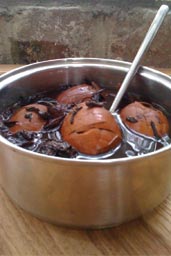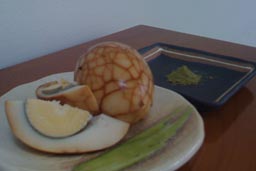Tea-Spiced Marbled Eggs (Cha Ye Dan)
 My two layer hens Martina and Aretha have obliged me by providing delicious fresh eggs for this Easter weekend, and it’s time for me to share with you my version of the traditional Easter egg. I’m going to talk about probably the most famous dish in the entire repertoire of Chinese tea cookery. For Chinese people tea-spiced marbled eggs are a much loved everyday ‘comfort food’. I hope that you will try them and come to love them too.
My two layer hens Martina and Aretha have obliged me by providing delicious fresh eggs for this Easter weekend, and it’s time for me to share with you my version of the traditional Easter egg. I’m going to talk about probably the most famous dish in the entire repertoire of Chinese tea cookery. For Chinese people tea-spiced marbled eggs are a much loved everyday ‘comfort food’. I hope that you will try them and come to love them too.
My starting point is my mum’s recipe. She uses common spices like cinnamon, cloves, fennel, coriander and szechuan peppercorns in combination with traditional medicinal herbs and roots, such as angelica sinensis (Chinese angelica), ligusticum wallichii (Szechuan lovage) and rehmannia glutinosa (Chinese foxglove). She brews the whole lot in a tea called Shui Xian. This is an oolong, which lies toward the oxidised end of the oolong spectrum, with a robust, caramelised palate and undertones of my favourite fruit longan (‘dragon eye’). Oddly, I grew up under the misapprehension that this tea was the better known Tie Guan Yin (‘Iron Goddess of Mercy’) because it’s often mis-sold under that name in my native South East Asia.
Some tea-spiced egg recipes call for Dragon Well, a green tea that I think would make the eggs too bitter. Pu-Er, a post-oxidised red tea, is commonly suggested, though it seems to me unwise to use a vintage Pu-Er in this way. I usually mix up a blend of Pu-Er, Keemun Black and Lapsang Souchong. Actually, any relatively oxidised and full-bodied black or red teas would work. Ordinary supermarket tea bags of darjeeling, assam, ceylon or earl grey, or what’s sometimes called ‘builders tea’, are perfectly suitable.
 Tea-spiced eggs bring back so many evocative memories of my childhood in Singapore. Night markets (‘pasak malam’ in Malay) where I used to go at weekends with my mum and brother. Street hawkers simmering the aromatic eggs in open pots. The clear plastic bags we used to buy the eggs in, with the little drops of poaching liquid. The sense of excitement – because this was a treat! – as I slowly peeled the hot, cracked shells to reveal the marbled patterns on the egg. How my mouth watered as I added the requisite sprinkling of ‘pepper salt’. And then, biting into the egg, tasting the delicate perfume of tea and the five spice. Gorgeous!
Tea-spiced eggs bring back so many evocative memories of my childhood in Singapore. Night markets (‘pasak malam’ in Malay) where I used to go at weekends with my mum and brother. Street hawkers simmering the aromatic eggs in open pots. The clear plastic bags we used to buy the eggs in, with the little drops of poaching liquid. The sense of excitement – because this was a treat! – as I slowly peeled the hot, cracked shells to reveal the marbled patterns on the egg. How my mouth watered as I added the requisite sprinkling of ‘pepper salt’. And then, biting into the egg, tasting the delicate perfume of tea and the five spice. Gorgeous!
If my mum did make the eggs at home, I remember the frustration of having to wait a whole day for the eggs to ‘cure’ in the poaching liquid. The wait was well worth it though! Mum would make 15-20 eggs at a time, which could keep in the fridge for a week, though in our family, they’d be lucky to last a couple of days!
She’d make them sometimes to accompany soy braised pork belly and tofu cubes. Absolutely yummy. Or she’d halve the eggs and add them into Chinese noodle soups. But the eggs can also be served warm with a little mayonnaise or cream cheese on a cracker topped with a slice of vinegared ginger – a really original canapé!
Here is my own simplified recipe for tea-spiced marbled eggs:
- 15g black or red tea leaves or 7-8 tea bags
- 10g star anise
- 2 cinnamon sticks
- 2g fennel seeds
- 2g cloves
- 1g szechuan peppercorns
- 1g coriander powder
- 20g caster sugar (or to taste)
- 2tbsp dark soy sauce (or to taste)
- 2g salt
- 1 chinese orange peel (optional)
- 6 hard-boiled standard eggs, or 12 quails eggs, preferably slightly mature
- Hard boil the eggs. Gently tap the eggs on your work surface so that the shell is cracked but intact. The cracks create a beautiful marbled effect on the egg white and more importantly allows the tea-spice to permeate the eggs.
- Add all ingredients (except tea) into a pot that is big enough to hold the eggs and a quarter pot full of water. Bring to a boil and ensure that the sugar has dissolved.
- Add the tea leaves/tea bags. Simmer for 3 minutes.
- Add the partially cracked eggs and if necessary add more water so that the poaching tea-spiced liquid is just covering the eggs.
- Simmer for an hour or so. Preferably leave to cure for a few hours (but its hard to resist eating them!)
- Reheat in the poaching liquid before eating.
- Serve with a mix of white pepper powder (or finely ground green tea) and fine salt. This brings out the umami of the tea and spices infused in the eggs.
This is my last blog before my big trip to Hangzhou and to Huangshan (‘Yellow Mountain’) in eastern China. On the hunt for more fascinating teas and tea cuisine ideas. I’ll be gone a month or so, but I’ll be back to share my tea adventures with you soon.
Happy Easter!
Pei
pei@teanamu.com
~~ sip a good brew, steal a slice of tranquility, glimpse a lingering fragrance, gladden the heart and refresh the mind ~~


How delicious and inspiring Pei’s dishes sound. It is all too easy just to tip wine into every dish and leave that to flavour otherwise tasteless meat and fish, tea is such a refreshing idea and a real change for the tastebuds.
thanks !! very helpful post!
This looks fabulous as i have my own hens and all of these spices i use regularly i will try these today.
xxxx
Hi Andrew
Have fun and enjoy! Let me know what you think of the eggs?
Pei x